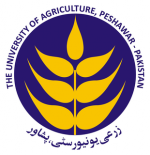Influence of Varying Salinity on Germination Indices and Threshold of Salt Tolerance in Alfalfa (Medicago sativa L.)
Influence of Varying Salinity on Germination Indices and Threshold of Salt Tolerance in Alfalfa (Medicago sativa L.)
Muhammad Azim Khan1, Muhammad Fawad1*, Aftab Jamal2, Arsalan Ali3 and Rizwan Ahmad3,4
ABSTRACT
A laboratory experiment was conducted to evaluate the impact of varying NaCl concentrations on germination indices of alfalfa (Medicago sativa L.). The study aims to determine the threshold level of salinity tolerance in alfalfa. Six salinity levels (50, 100, 150, 200, 250, and 300 mM) and a control (distilled water) was arranged in a completely randomized design with three replicates. One-way ANOVA revealed that germination percentage was reduced by 80%, germination index was 98%, while germination energy and germination vigor index was declined by 95%. However, the mean germination time was increased significantly, which indicated a delay in germination at the higher salt concentration. Significant reduction in germination (30%) was at 250 mM with a lowest germination (10%) recorded at 300 mM. Pearson’s correlation matrix for germination indices (germination energy, germination rate index, mean germination rate, and germination vigor index) revealed a strong negative correlation with salinity. In contrast, mean germination time was negatively correlated with all the germination indices, which indicated that at higher salt concentration the seeds would take more time in germination or could be permanently inhibited. Second order polynomial regression model showed a declined slope for germination %, germination energy, and germination index across varying salt concentrations with R² values of 0.93, 0.97, and 0.96, respectively, which showed that increase in salinity significantly reduced germination efficacy of alfalfa. However, an improved germination efficiency and germination vigor index was observed under low to moderate salinity level. These results showed the threshold limit of salinity and its damaging effect on alfalfa. In light of these findings it is concluded that alfalfa seeds could tolerate salinity stress ranged from 50 and 150 mM, beyond which germination and seedling growth substantially reduced. It is suggested that alfalfa can germinate and survive well under moderate to high salinity concentration. Therefore, alfalfa could be an alternative crop for fodder production in the saline regions.
To share on other social networks, click on any share button. What are these?







